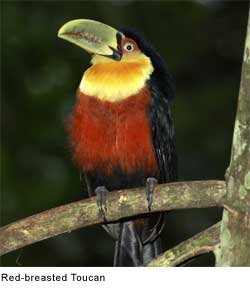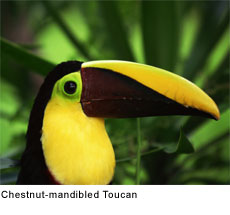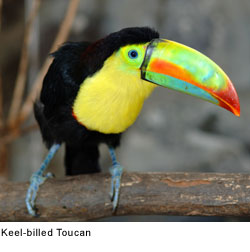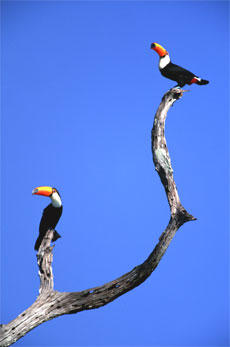|

 Weights and Measures: Toucans range in size from 18 to 63 cm (from 7 to 25 in). Their bodies tend to be short and thick and their tails are rounded, and vary in length from half the length of the body to the whole length. Weights and Measures: Toucans range in size from 18 to 63 cm (from 7 to 25 in). Their bodies tend to be short and thick and their tails are rounded, and vary in length from half the length of the body to the whole length.
Record-breaking Beak:
The neck is short and thick while at the base of the head is a huge, brightly-colored beak that measures in some large species, more than half the length of the body.
A Toucan's tongue is long, narrow, and singularly frayed on each side, adding to its sensibility as an organ
of taste.
Strong and Stout: The legs of a Toucan are strong and rather short. Their toes are arranged in pairs with the first and fourth toe turned backward.
Bird of Many Colors: Both males and females are the same color. The feathers in the genus containing the largest toucans are generally colored black, with touches of white, yellow, and scarlet. The under parts of smaller aracari toucans are yellow, crossed by one or more black or red bands, and the edges of the beak are saw-toothed. The toucanets have mostly green plumage with blue markings.

 I'll Have an Apple... Or, a gecko. Toucans are frugivorous (fruit-eating), but will gulp down insects and other small prey, such as small lizards. I'll Have an Apple... Or, a gecko. Toucans are frugivorous (fruit-eating), but will gulp down insects and other small prey, such as small lizards.
Nest and Nestlings: They are arboreal and nest in tree holes laying 2–4 white eggs. The young hatched are completely naked, without any down.
There's No Place Like Home: They are resident breeders and do not migrate. Toucans are usually found in pairs or small flocks.
-----------------------------------------------------------------------------------------------------------------------------
Keel-billed Toucan:
The Keel-Billed Toucan, Ramphastos sulfuratus, is a colorful South American bird with a large bill. This social bird lives in small flocks in lowland rainforests, but as it is a poor flyer, the toucan moves mostly by hopping around trees. Toucans roost in holes in trees, and they have a croaking call that sounds like "RRRRK."
 Hole in the Tree: Keel-billed toucans can be found from Southern Mexico to around Venezuela and Colombia. They roost in the canopies of tropical, subtropical, and lowland rainforests. They make their homes in holes in trees, often living with several other toucans. This can be a very cramped living space, so they have learned how to tuck their tails and beaks under them to conserve space while sleeping. Hole in the Tree: Keel-billed toucans can be found from Southern Mexico to around Venezuela and Colombia. They roost in the canopies of tropical, subtropical, and lowland rainforests. They make their homes in holes in trees, often living with several other toucans. This can be a very cramped living space, so they have learned how to tuck their tails and beaks under them to conserve space while sleeping.
Big Beak, Big Appetite: The diet of Keel-billed toucans consists mostly
of a wide range of fruit, but may also include bird eggs, insects, lizards, tree frogs. Their bill, surprisingly dexterous, allows them to eat a large variety of fruit that might not otherwise be reached. When eating the fruit, Keel-billed toucans will use their bill to pick the fruit, and then toss their heads back and swallow the fruit whole.
Why Live Alone? Like many toucans, Keel-billed toucans are very social, very playful birds. They travel in flocks of approximately six to twelve other birds, and have a family structure within their group.
 A Family That Plays Together, Stays Together... They will often be seen "dueling" with each other with their bills, and throwing fruit into each other's mouths. As mentioned before, the Keel-billed toucans live together in these groups, often sharing cramped living quarters of holes in trees. They are rarely seen alone. A Family That Plays Together, Stays Together... They will often be seen "dueling" with each other with their bills, and throwing fruit into each other's mouths. As mentioned before, the Keel-billed toucans live together in these groups, often sharing cramped living quarters of holes in trees. They are rarely seen alone.
A Tightly Knit Family: The female Keel-billed toucan will usually lay one to four white eggs in a grouping called a clutch. The male and female, having formed a strong bond, take turns sitting on the eggs, which hatch in approximately 15-20 days after being laid. After hatching, the male and female again take turns feeding the chicks. The chicks will stay in their nest for approximately eight to nine weeks as their bills develop fully and they become ready to fly.

- Aulacorhynchus
- Emerald Toucanet, Aulacorhynchus prasinus
- Groove-billed Toucanet, Aulacorhynchus sulcatus
- Chestnut-tipped Toucanet, Aulacorhynchus derbianus
- Crimson-rumped Toucanet, Aulacorhynchus haematopygus
- Yellow-browed Toucanet, Aulacorhynchus huallagae
- Blue-banded Toucanet, Aulacorhynchus coeruleicinctis
- Pteroglossus
- Lettered Aracari, Pteroglossus inscriptus
- Green Aracari, Pteroglossus viridis
- Red-necked Aracari, Pteroglossus bitorquatus
- Ivory-billed Aracari, Pteroglossus azara
- Brown-mandibled Aracari, Pteroglossus mariae
- Chestnut-eared Aracari, Pteroglossus castanotis
- Black-necked Aracari, Pteroglossus aracari
- Collared Aracari, Pteroglossus torquatus
- Fiery-billed Aracari, Pteroglossus frantzii
- Stripe-billed Aracari, Pteroglossus sanguineus
- Pale-mandibled Aracari, Pteroglossus erythropygius
- Many-banded Aracari, Pteroglossus pluricinctus
- Curl-crested Aracari, Pteroglossus beauharnaesii
- Baillonius
- Saffron Toucanet, Baillonius bailloni
- Andigena
- Plate-billed Mountain Toucan, Andigena laminirostris
- Gray-breasted Mountain Toucan, Andigena hypoglauca
- Hooded Mountain Toucan, Andigena cucullata
- Black-billed Mountain Toucan, Andigena nigrirostris
- Selenidera
- Yellow-eared Toucanet, Selenidera spectabilis
- Golden-collared Toucanet, Selenidera reinwardtii
- Tawny-tufted Toucanet, Selenidera nattereri
- Guianan Toucanet, Selenidera culik
- Spot-billed Toucanet, Selenidera maculirostris
- Gould's Toucanet, Selenidera gouldii
- Ramphastos
- Keel-billed Toucan, Ramphastos sulfuratus
- Choco Toucan, Ramphastos brevis
- Citron-throated Toucan, Ramphastos citreolaemus
- Channel-billed Toucan, Ramphastos vitellinus
- Yellow-ridged Toucan, Ramphastos vitellinus culminatus
- Red-breasted Toucan, Ramphastos dicolorus
- Chestnut-mandibled Toucan, Ramphastos swainsonii
- Black-mandibled Toucan, Ramphastos ambiguus
- White-throated Toucan, Ramphastos tucanus, includes
- Red-billed Toucan, R. t. tucanus
- Cuvier's Toucan, R. t. cuvieri
- Toco Toucan, Ramphastos toco
All text is available under the terms
of the GNU Free Documentation License
|